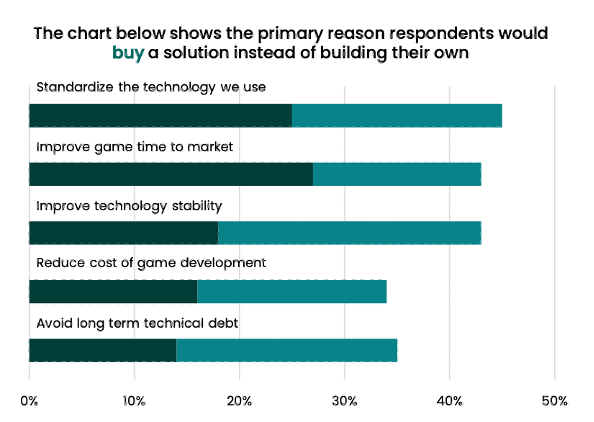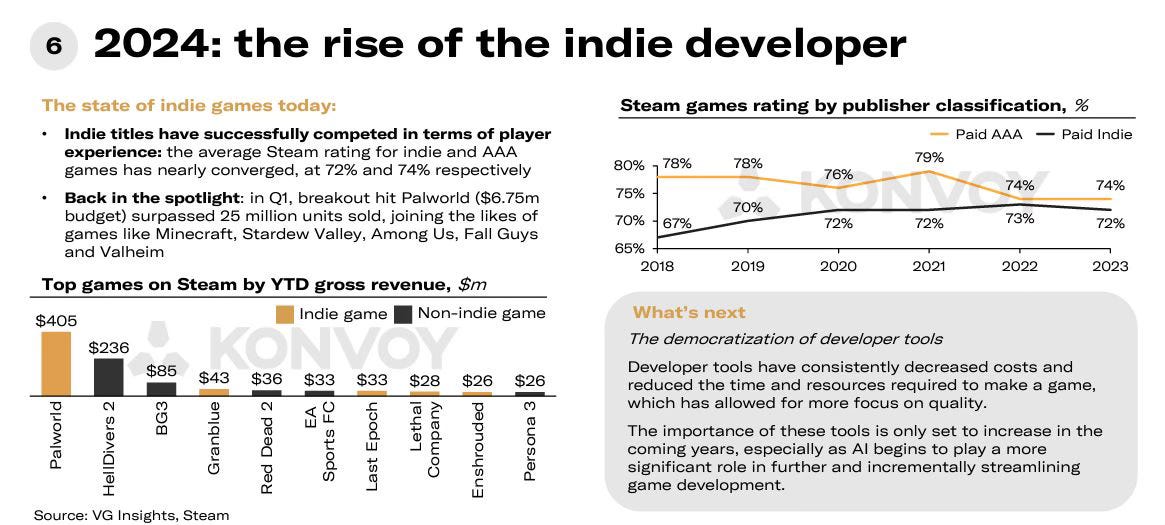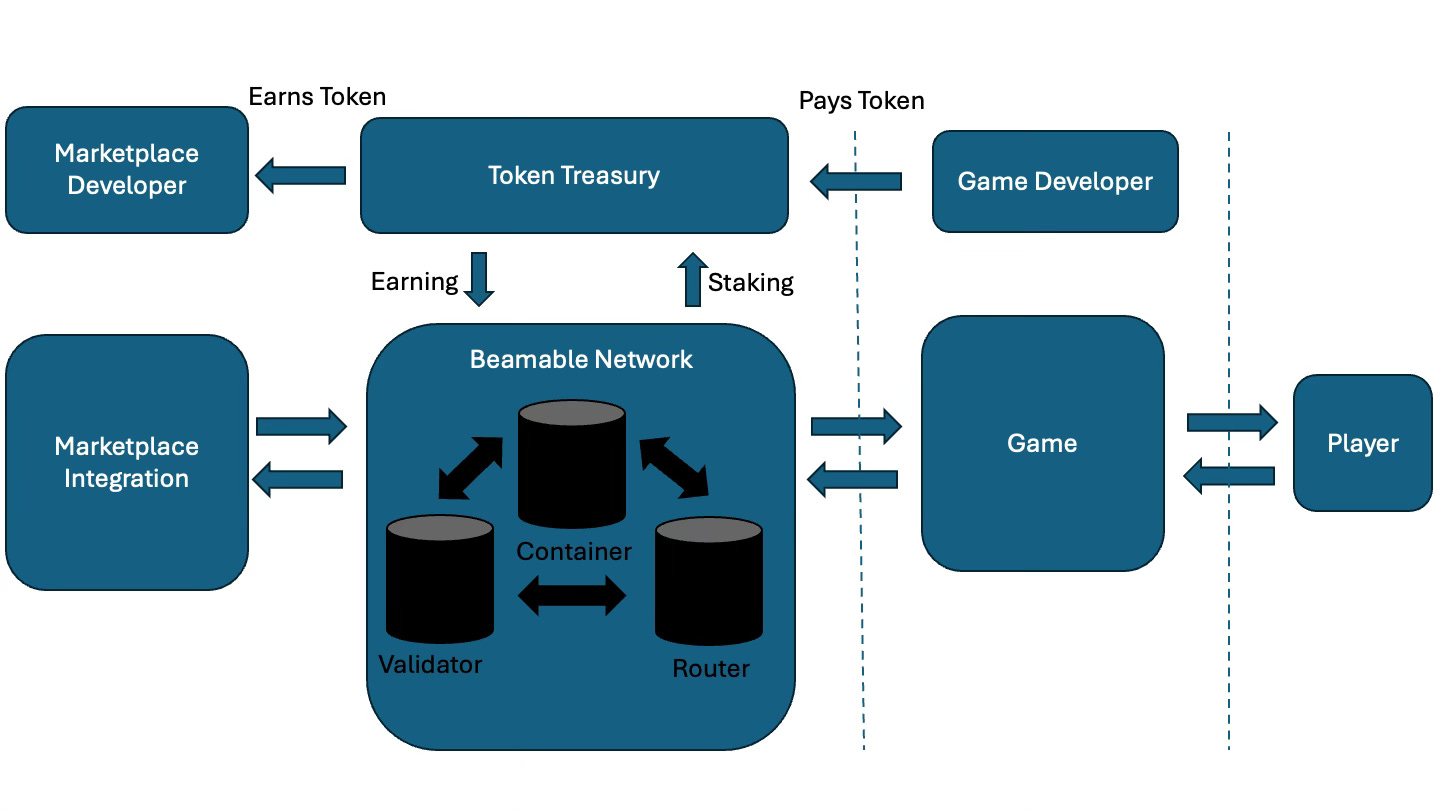Decentralized Game Infrastructure
Scaling, Derisking and Democratizing Live Games with DePIN
Most revenue in the game industry comes from live services games. Yet this remains one of the most complicated, expensive, and risky aspects of game development. Thus far, every game company has either built the enabling technologies themselves or relied on a centralized service provider.
But that’s about to change.
In this article, I’ll share some background on how important live services is to gaming, and how decentralization will change everything.
Live Services is Eating Gaming
In a poll of over 500 game studios, 95% of them are already operating—or intend to release—a live services game.
Live Services games are those with online components. Online features can range from the simple (occasional content updates or cooperative features) to the complex (complicated social systems, real-time interaction or virtual economies). Live features tend to increase a game’s key metrics—retention, revenue, engagement—and are here to stay.

In the past, game studios built their own live services technology. This is how games like World of Warcraft and League of Legends were built. These companies were the pioneers, and few examples came before them. Yet building this infrastructure frequently costs tens of millions of dollars to build; one 2024 research report put the average cost at approximately $22M per studio.
Studios Prefer Buying to Building
It makes sense for studios to buy their live services technology instead of building it themselves: in a market where fun and development velocity are paramount, the risks and costs of a home-brew solution are often too great.
The early market of backend technology included PlayFab (now part of Microsoft) and GameSparks (acquired by Amazon, and subsequently discontinued). My company, Beamable, released our first product in 2022 after years of development (first begun at Disruptor Beam, where we shipped live games to over 20 million players). Our ambition is to offer a more open, extensible and workflow-oriented solution for game developers. Studios see many reasons to buy:
Opportunity for Independent Developers
Buying instead of building is a process of democratization: much as the emergence of off-the-shelf 3D engines such as Unity and Unreal made it possible for smaller teams to dream bigger.
Platforms like Unity, which deserves a lot of credit for democratizing the 3D graphics market, enabled the creation of extremely large and successful live services titles; examples include billion-dollar hits like Hearthstone and Pokemon Go. In both of these cases, they drew upon a deep legacy of backend technology expertise within their teams.
In 2024, the most successful new launches on Steam (Palworld, Helldivers 2) are live games built by smaller teams:
In the long-tail in this market are all-in-one “metaverse” platforms such as Roblox. These platforms show us where we’re heading: a world in which if you can imagine it, you can get it onto the screen. However, current metaverse platforms are extremely centralized, have high rents, and are subject to top-down censorship and are ultimately limited in their expressiveness.

We are in a process of transformation—one in which the tools are becoming interoperable, extensible and democratized. The largest opportunity for the widest number of developers will happen as we move into Creator Era, as games become primarily a creative task instead of a technical one.
The Problem of Trust
Live services technology is a trust business: these products can control the destiny of a game. Even small amounts of downtime can result in massive losses—and an outright failure to scale can be catastrophic to a new launch.
As noted above, platforms can come and go: even a large platform-owner like Amazon is no guarantee of continuity, as thousands of games learned when GameSparks was discontinued. Nor have people been immune to massive price shifts, such as Microsoft’s push to move developers from PlayFab CloudScript to Azure Functions—sometimes at 10X the cost.
Decentralization: a Solution to Trust
Beamable was originally developed as a cloud-based software-as-a-service (SaaS) product. Go to the website, sign up, and begin building the online parts of your game in minutes.
Yet we started hearing from larger publishers who wanted the ability to self-host. That led us to the first decentralized version of Beamable, which we called Private Cloud. This lets game studios operate the Beamable software on their own infrastructure, which gives them the security and continuity of operating the tech stack in-house.
Whether you choose the SaaS or Private Cloud version of Beamable, it is built around a highly-scalable microservices architecture using docker containers. This architecture enables custom C# code to be executed in the cloud, and scaled-up as demand requires. This is supported by an SDK for Unity and Unreal that makes it easy to create server code for your game, plus dozens off-the-shelf managed services and a marketplace of third-party add-ons.1

All of this got us thinking: what if we could fully decentralize our microservices architecture, and distribute it to a network of independent node operators? This had been done in the past for platforms like Seti@Home and Folding@Home, where the underused computational capacity in everyday computers was tapped to search for extraterrestrial life and solutions to disease. Indeed, during the early months of the Covid-19 pandemic, Folding@Home aggregated compute from enough computers to create a 1.5 exaflop virtual supercomputer.
What if you could aggregate unused computational capacity to do the same for computer gaming, and forever free studios from reliance on centralized tech, expensive backend buildouts and the whims of larger infrastructure companies?
You can:
Introducing: Decentralized Physical Infrastructure Networks (DePIN)
Whereas donating computational time is appropriate for nonprofit projects like Folding@Home and Seti@Home, many others simply need a commercial solution that incentivizes computer operators to join networks. Blockchain is an ideal framework for distributing and implementing such projects, by providing the accountability and composability layer—while leaving the actual workloads to the technologies best suited to those tasks.
Today, there are Decentralized Physical Infrastructure Networks (DePIN projects) for a wide variety of applications that require specialized infrastructure. These projects are built around high-performing tech stacks where blockchain is used to provide the accounting and compensation mechanisms. Examples include:
Helium: install a WiFi router anywhere you want, and allow network subscribers to access the Internet through your device—paying you in the network currency for making it available.
Theta Network: a decentralized cloud for media, AI and entertainment; Theta distributes video streaming across individual node operators, and have a computational service that has implemented protein-folding within their network.
Aethir: harnesses cloud-based GPUs to enable rendering, cloud-based gaming and AI applications.
Beamable: Gaming Infrastructure for the Decentralized Era
Beamable is setting forth on the next step of our journey: taking the decentralized “Private Cloud” edition of Beamable, and integrating it with a node-based blockchain architecture that will enable thousands of node operators to contribute services back to commercial game developers:
Game developers will gain access to much less expensive infrastructure, sourced from enterprise-grade operators around the world.
Game players will also benefit, because studios will retain more of the money they earn, which means reinvesting it in great gameplay.
Game developers will no longer rely on a centralized provider; the network will consist of countless operators who are interested in earning income by supporting the game industry.
And since it is all built on the Beamable tech stack, it means things like integrated workflow in Unity and Unreal; support for languages game developers like (such as C#) and a marketplace of off-the-shelf options for building your game. Beamable will also create economic incentives for backend developers to add their own custom gaming modules to the ecosystem!
Since this is gaming infrastructure—not the games themselves—it is appropriate for any kind of game that needs servers. This includes not only new web3 games, but the vast number of online web2 games that will continue to be developed.
Let’s take a high-level look into the architecture of the Beamable DePIN:
Beamable DePIN Network Architecture
Container
Container nodes are where the actual computation happens. Beamable containers allow flexible microservices to be executed, which can include everything from custom C# game logic, to off-the-shelf “games as a service” modules and third-party plugins.
Routers
Routers are API gateways that link games to the containers capable of delivering the appropriate quality of service (QoS) they need; accounting for factors such as latency (relative to the players and game servers favoring high-speed edge nodes where possible), the container nodes quality-of-service history and overall performance.
One of the keys for decentralized infrastructure is ensuring that the games (and consequently, the players of those games) receive the QoS they’re responsible for. Some games, such as a realtime MMORPGs, may require ultra-low-latency responses and have the unit economics to support it. Others (e.g., turn-based strategy games) might be able to accept lower latency. In a DePIN network, you can allow game studios to a bid a premium when they require enterprise-grade QoS; likewise, game studios could bid at a lower rate for infrastructure when their needs are more modest.
Validators
Validators are a decentralized network of nodes that check the containers to confirm that they deliver the workloads they report, cross-referencing with other validators and the games that provision services. Nodes that report inaccurate data (i.e., data that falls out of consensus with the network) can be penalized or even banned from the network.
It is important to note that the workloads associated with games occurs off-chain (there’s no reasonable way to implement high-performing game logic or game servers within smart contracts alone) and the on-chain elements involve the accounting and validation of work:
Beamable DePIN Technology To-date
We’ve already implemented the following decentralized technologies on Beamable:
All the metering and QoS telemetry for accounting of compute usage is in place
A distributed actor system allows for workloads to operate closer to where users are, such as edge nodes on a far-flung network
Beamable Microservices can run anywhere on the internet (your own developer workstation, hyperscalers, edge nodes, etc.) and bind to the Beamable Network
The Beamable Marketplace allows developers to easily adopt packaged Microservices, and deploy them to their environments in an adhoc manner
Beamable infrastructure is fully codified, as part of the Private Cloud offering, and can already be deployed in customer cloud accounts
All Beamable tooling, SDK, and workflows are designed bottom up to be compatible with both private deployments, multi-tenanted deployments and the decentralized network
Beamable “federated services” allows for last-mile, single-point solution to be plugged in to standardized API interfaces, which reduces implementation surface area
We’ll be sharing more about our DePIN technology roadmap in the coming weeks.
Stay Tuned
We’ll be revealing more about the Beamable DePIN in coming weeks.
To stay tuned-in, here are a few places you’ll want to follow:
Follow me on X: @jradoff
Follow me on LinkedIn
Follow Beamable on X
And of course, subscribe here—I write about virtual worlds, AI, games, decentralization and game infrastructure:
Legal notice:
All Content here is information of a general nature and does not address the circumstances of any particular individual or entity. Nothing here constitutes professional and/or financial advice, nor does any information here constitute a comprehensive or complete statement of the matters discussed or the law relating thereto. You alone assume the sole responsibility of evaluating the merits and risks associated with the use of any information here before making any decisions based on such information. At no point does this information provide any expectation of potential profitability for any entity and/or asset
For an example of microservices and third-party plugins at work in Beamable, you can check out the Generative AI game that won the a16z Tech Week Virtual Worlds Hackathon, or Genamon, an example that combines blockchain and genAI.










Hi sir
LFG